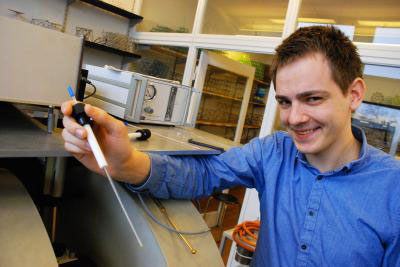| Mar 28, 2011 |
Heavy metals open path to high temperature nanomagnets and radically smaller storage
|
|
(Nanowerk News) How would you like to store all the films ever made on a device the size of an I-phone?
|
|
Magnets made of just a few metallic atoms could make it possible to build radically smaller storage devices and have also recently been proposed as components for spintronics devices. There's just one obstacle on the way. Nano-sized magnets have only been seen to work at temperatures a few hairs above absolute zero.
|
|
Now a chemistry student at the University of Copenhagen has demonstrated that molecular magnets using the metals ruthenium and osmium retain their magnetic properties at higher temperatures. Most likely due to the larger spin-orbit coupling and more diffuse electron cloud present in these heavier elements. Some of his findings have recently been published in Chemistry – A European Journal.
|
 |
| Magnets made of just three to five atoms will allow for computer storage to shrink millionfold. Now a chemist from University of Copenhagen has discovered a route to workable nano-magnets. The solution? Heavy non-iron metals.
|
|
Kasper Steen Pedersen is studying for a Masters degree at the University of Copenhagen. Like many others in his chosen field of molecular magnetism he had been working with magnets based on 3d metal ions from iron. This seems an obvious choice when working with ordinary magnets which usually consist of about a trillion atoms. Single-molecule magnets are isolated molecules behaving like real magnets but they do not exhibit a three-dimensional order characteristic of a magnet. Though interesting from a perspective of fundamental research, the need for very low temperatures make the miniscule magnets useless for any practical applications. So Pedersen wanted to see if another tack was possible.
|
|
"When you take a look at the periodic table of the elements the solution seems obvious. Ruthenium and osmium are in the same group in the periodic table as iron, so it ought to be possible to create magnets out of these substances as well by using our knowledge about molecular magnets based on iron" says Pedersen.
|
|
As it turned out the chemical synthesis needed to build molecular magnets out of the substances was relatively simple. But the measured properties were surprising.
|
|
"The chemical properties are the same for these metals as for iron. But the physical properties of the new magnets turned out to be very different from those made of iron. Basically, the magnetism arises from the electron spin but also from the motion of the electron around the nucleus. The latter contribution, which is very large for ruthenium, osmium and other heavy elements, has been largely ignored by the scientific community but we have now shown, experimentally, that is a very pronounced effect. And this is utterly new and exciting", explains Kasper Steen Pedersen.
|
|
Using the unconventional metals for his magnets enabled Pedersen to raise the critical temperature only by a few Kelvin. However, the intriguing result that electron motion plays a large role for the magnetic properties paves the way for new synthetic approaches to molecular nanomagnets with unprecedented high critical temperatures.
|
|
"You'll not get me to call this a breakthrough. But it is a remarkable result for the field", concludes Kasper Steen Pedersen.
|

